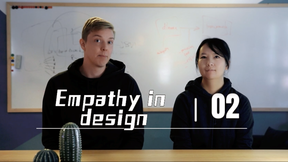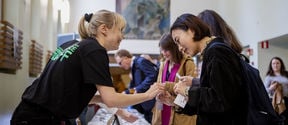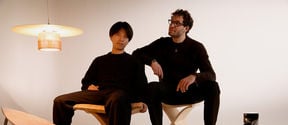Designing with empathy

Soft skills have become hard currency in design work. The larger the role of technology becomes in our lives, the more it needs to be shaped to human needs. Making human-friendly technology calls for empathic design. The accuracy of empathic understanding can be both measured and improved, say doctoral researchers Jie Li and Antti Surma-aho.
Empathy can be defined as an unconscious or conscious attempt to understand another person's thoughts. ‘Empathy is a way of narrowing the gap between people, of stepping into another person’s shoes,’ says Li.
But how accurately can an engineer or designer understand what’s happening in a user’s head? To investigate this, Li, Surma-aho and their colleagues developed a quick version of a method widely used in psychology to measure the accuracy of empathic understanding.
At the start of the measurement, users are asked to describe their experiences with a product or service. The interview is recorded, and the users watch the recording immediately after the interview. While watching, they are asked to pause the recording at moments when they had notable thoughts or feelings and to describe them.
The designers then watch the recording and try to guess what kind of thoughts feelings the interviewees wrote down during the pauses. Finally, the researchers score the similarity between the interviewers and the designers.
According to Li and Surma-aho, the accuracy of empathic understanding varies between 8 and 64 percent. The accuracy was higher when users and designers had similar experiences. People of the same gender also understood each other more accurately, as did those who grew up in the same national culture.
Li therefore offers important advice to people aiming for international markets: if you’re not familiar with the culture of the target market, recruit local experts, live in the destination country or at least visit it.
In her doctoral thesis, Li studied how to help drivers improve their safety. The research involved drivers from China and Finland, as well as designers from China, Finland and other European countries.
It can be challenging for a Finnish designer to step into the shoes of a driver in a major Chinese city. ‘However, our research showed that even a short business trip clearly increases the accuracy of empathic understanding,’ Li says.
Continuing curves and new services
Product development usually follows an S-shaped curve, with a slow start followed by a steep rise that is driven by technological breakthroughs and finally a plateau phase. The user usually enters the picture in the plateau phase, Antti Surma-aho says – and for good reason.
‘Let’s take a medical device, such as an ultrasound scanner, as an example. The image on the device must be clear and the device itself must be safe to use before it is time to think about user-friendliness and make small improvements that make the device more attractive and comfortable to use.’
Working life skills are often divided into hard skills, which are learned through education or working, and soft skills. The latter are more difficult to measure, such as communication and creativity – as well as empathy. However, Surma-aho says it’s clear that soft skills can be used to keep the S-curve rising and even to create completely new services that revolutionise people's lives.
For example, the OP group reorganised its technically well-functioning asset management services from the ground up around user experience. Likewise, the Mobility as a Service (MaaS) concept arose from understanding that combining the available options to create a smooth travel experience is often difficult or even impossible. ‘And Tinder’s birth was influenced by the realization that it can be really difficult to approach someone without knowing whether they are interested in you – and that going out in the rain is no fun,’ Surma-aho says.
In addition, social bubbles that hinder empathic understanding can also emerge within a country, Surma-aho says. ‘Many designers are young, urban, highly educated and reasonably well-off, so it’s important to know how to break out of that bubble when considering, for example, banking services for older people or smooth mobility in hospital areas.’
Surma-aho and Li will defend their doctoral theses on October 24 and 25. The theses are part of the five-year Empathic Engineers project, which is funded by the Jane & Aatos Erkko foundation and the Technology Industries of Finland Centennial Foundation.
The Empathetic Engineers project also involves Professors Katja Hölttä-Otto and Mikko Sams, Aalto Brain & Mind Lab and Design Factory.
House rules for emphatic engineers / designers
- Forget superficial surveys! They simply confirm or reverse your own assumptions; they don’t explain what a user is thinking. For example, if you want to learn about ice cream preferences and ask users to pick their favourite from vanilla, pistachio, liquorice and rum chips, the winner would probably be vanilla because no one hates it – even though they might prefer other flavours or want to try different ones every day.
- If you’re not an expert in human research, the surest way to understand others and overturn your preconceptions is to start by simply talking and listening, not by surveying.
- Continue to take the user’s thoughts into account after the design phase or when the product is already on the market and correct any deficiencies!
‘When I came to Finland in 2018, Nordea was the only Finnish bank that had an online bank in English. This meant that practically all Chinese people living here were Nordea's clients until the other banks caught up,’ Li tells. - The desire to understand and help is great, but make sure that the understanding also creates new solutions and business. In other words, do not get stuck in empathy.
Contact:
Jie Li, doctoral researcher
[email protected]
Antti Surma-aho, doctoral researcher
[email protected]
- Published:
- Updated:
Read more news

Program now available for the sustainability event of the year - Speakers include economist Kate Raworth and president Tarja Halonen
This year, Sustainability Science Days, a joint event of Aalto University and the University of Helsinki is collaborating with the world's largest Sustainability Research and Innovation Congress SRI. The event will bring together 2,000 experts to solve global sustainability challenges.
A new way to do controlled experiments in medicine: simulate the control
Generative AI could augment randomized controlled trials.